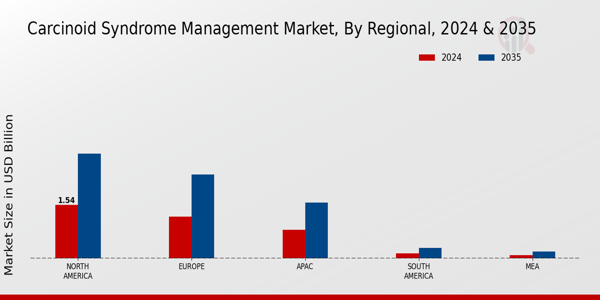Emergence of Targeted Therapies
The emergence of targeted therapies is transforming the Carcinoid Syndrome Management Market. Recent developments in pharmacological research have led to the introduction of novel agents that specifically target the underlying mechanisms of carcinoid syndrome. These therapies, which may include somatostatin analogs and other innovative treatments, are designed to alleviate symptoms and improve the quality of life for patients. The increasing availability of these targeted options is likely to attract more patients seeking effective management solutions, thereby expanding the market. Furthermore, as clinical trials continue to validate the efficacy of these therapies, healthcare providers may become more inclined to adopt them in their treatment protocols, further driving market growth.
Advancements in Diagnostic Techniques
Advancements in diagnostic techniques are significantly influencing the Carcinoid Syndrome Management Market. Enhanced imaging modalities, such as PET scans and MRI, along with improved biomarker identification, facilitate earlier and more accurate diagnosis of carcinoid tumors. This early detection is crucial, as it allows for timely intervention and management of carcinoid syndrome, which can improve patient outcomes. The integration of these advanced diagnostic tools is likely to increase the number of diagnosed cases, thereby expanding the market for management solutions. Furthermore, as diagnostic capabilities continue to evolve, healthcare professionals may become more adept at recognizing carcinoid syndrome, leading to a greater demand for targeted therapies and comprehensive management strategies.
Rising Incidence of Neuroendocrine Tumors
The increasing incidence of neuroendocrine tumors, particularly carcinoid tumors, appears to be a primary driver for the Carcinoid Syndrome Management Market. Recent data indicates that the prevalence of these tumors is on the rise, with estimates suggesting that they account for approximately 2% of all gastrointestinal tumors. This growing patient population necessitates enhanced management strategies, thereby propelling the demand for effective treatment options. As awareness of carcinoid syndrome expands, healthcare providers are likely to seek innovative therapies and management solutions, further stimulating market growth. The need for specialized care and tailored treatment plans for patients suffering from carcinoid syndrome is becoming increasingly evident, which may lead to a more robust market landscape in the coming years.
Supportive Government Policies and Funding
Supportive government policies and funding initiatives are emerging as crucial drivers for the Carcinoid Syndrome Management Market. Governments are increasingly recognizing the need for enhanced healthcare solutions for rare diseases, including carcinoid syndrome. Funding for research and development, as well as incentives for pharmaceutical companies to develop new treatments, is likely to foster innovation in this field. Additionally, policies aimed at improving access to care for patients with carcinoid syndrome may lead to increased utilization of management strategies. As these supportive measures continue to evolve, they are expected to create a more favorable environment for market growth, ultimately benefiting patients and healthcare providers alike.
Growing Awareness and Education Initiatives
Growing awareness and education initiatives regarding carcinoid syndrome are playing a pivotal role in shaping the Carcinoid Syndrome Management Market. Increased efforts by healthcare organizations and advocacy groups to educate both patients and healthcare providers about the symptoms and implications of carcinoid syndrome are likely to lead to earlier diagnosis and treatment. This heightened awareness can result in a larger patient population seeking management options, thereby driving market growth. Additionally, educational campaigns may encourage research and development of new therapies, as stakeholders recognize the need for effective management solutions. As awareness continues to rise, the market for carcinoid syndrome management is expected to expand, reflecting the evolving landscape of patient care.


















Leave a Comment